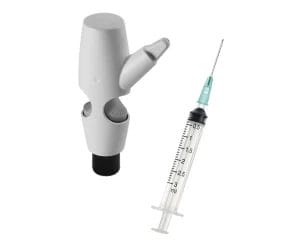Did you know—some people who live with migraine disease experience attacks that go from level 1 to 10 in just minutes? What can you do when the pain level is already debilitating? What about those attacks that you can catch quickly while the pain level is very low—should there be a different approach to them?
There are many abortive treatment options available, and knowing ahead of time which route to take when a migraine hits can be really difficult, but so important. Add in quantity limitations, and wanting to save certain medications for more severe attacks or special occasions you can’t miss, you may end up with a problematic delay in pain relief. Sadly, this sometimes results in more intense pain, or an attack that lasts longer and is more resistant to treatment.
So, how can you plan ahead to know how best to treat an attack based on the level of pain experienced?
Treating an Attack with Low Pain
 With lower head pain, lifestyle changes such as migraine glasses, green light therapy, ice packs, heat packs, relaxation, and other modalities might work. If so, this allows you to save the prescription abortive medications for a more severe attack, without having to worry about side effects or contraindications. This is especially helpful in case the attack suddenly changes course, and abortive medication becomes necessary.
With lower head pain, lifestyle changes such as migraine glasses, green light therapy, ice packs, heat packs, relaxation, and other modalities might work. If so, this allows you to save the prescription abortive medications for a more severe attack, without having to worry about side effects or contraindications. This is especially helpful in case the attack suddenly changes course, and abortive medication becomes necessary.
FDA-cleared medical devices such as the Nerivio, Relivion, CEFALY or gammaCore can also be helpful at this stage.
Treating an Attack with Moderate Pain
This can be the trickiest decision stage because quality of life is starting to become impaired but you aren’t totally debilitated. Taking an abortive medication and/or using a medical device will most likely be front and center on the list of options for this stage.
Remember, oral tablets and capsules take longer to work, especially during an attack when your GI system may not be absorbing normally, and most medications and devices work best when taken early on. If you know your headache pattern, and know an attack that gets to this level has a likelihood of escalating, that may play a part in your decision-making as well.
Pairing the abortive medication and/or device with basic items like heat, ice, migraine glasses and laying down in a dark room if possible is also helpful so that you can remain comfortable while the treatment, or treatments, take effect.
Treating an Attack with Severe Pain
 When a migraine attack includes severe pain, thinking will generally be impaired. This is where it’s really crucial to have a plan of action ahead of time to help you navigate your options. Knowing what you have taken up to this point can determine what you can take now. When pain is severe, stopping it as quickly as possible or at least getting it to come down to a lower level, is typically first on the agenda.
When a migraine attack includes severe pain, thinking will generally be impaired. This is where it’s really crucial to have a plan of action ahead of time to help you navigate your options. Knowing what you have taken up to this point can determine what you can take now. When pain is severe, stopping it as quickly as possible or at least getting it to come down to a lower level, is typically first on the agenda.
Tablets and capsules, even ODT tablets, have to go through the GI system and therefore are slow to take effect. They may even be ineffective if you have severe nausea or vomiting. In comparison, injections and nasal sprays are able to get to work much more quickly. FDA-cleared devices are often another great way to help the pain, often in combination with an abortive medication – they may even help to bring down the pain level a bit while you wait for the abortive to work, especially if it is early in the attack. The combination of abortive medication, devices and basic tools like ice, heat, green light and migraine glasses can all work together to bring the attack under control more quickly.
Track Your Attacks and Talk to Your Doctor
Knowing your pain level and how abortive treatments work for your body can determine which treatment, or treatments, to try, and in what order. Creating a list of your options by looking at past experience and talking with your doctor, can help you know what works best when you have trouble remembering. Having space to write down what you take and when to take it, can help you not to overdose or use a second medication too quickly.
So ask your doctor what your abortive options are. Have him write down what treatments are appropriate for you, when you should take them, when a second dose might be allowed, and when you should consider going to a more aggressive rescue medication option or options.
Let Us Know
What level of pain do your attacks generally reach? Does that impact which treatment options work best for you? What does your abortive treatment plan look like when you consider pain level?